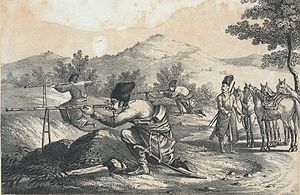Battle of Khwar Pass
| Battle of Khwar Pass | |||||||
|---|---|---|---|---|---|---|---|
| Part of Nader's Campaigns | |||||||
 Persian sharpshooters | |||||||
| |||||||
| Belligerents | |||||||
 Safavid Loyalists Safavid Loyalists |  Hotaki dynasty Hotaki dynasty | ||||||
| Commanders and leaders | |||||||
| Nader Shah | Ashraf Hotak | ||||||
| Casualties and losses | |||||||
| Minimal | Heavy
| ||||||
- v
- t
- e
- Battle of Gulnabad
- Siege of Isfahan
- Sangan
- Sabzevar
Afghan Campaigns
- 1st Afghan Campaign
- Kafer Qal'eh
- Herat 1729
- 2nd Afghan Campaign
- Qandahar
- Damghan
- Khwar pass
- Murche-Khort
- Isfahan
- Zarghan
First Ottoman War
- West Persian Campaign
- Tahmasp's Campaign
- Mesopotamian Campaign
- Siege of Baghdad
- Samarra
- Kirkuk
- Caucasus Campaign
- Ganja
- Siege of Iravan
- Khyber Pass
- Battle of Karnal
- Sack of Delhi
- Sindh Expedition
- Battle of Chenab (1739)
Second Ottoman War
- Siege of Mosul
- Siege of Kars
- Battle of Kars
Rebellions & Civil War
- Rebellion of Sheikh Ahmad Madani
- Bakhtiyari Rebellions
- Rebellion of 1733
- Kartli Revolt of 1736
- Derajat Rebellion
- Balkh Revolt of 1741
- Kish mutiny
- Revolt of Sam Mirza
- Khoy Revolt of 1743-46
- Kartli Revolt
- Fars Rebellion of 1744
- Qajar revolt of 1744
- Kerman Revolt of 1746
- Sistan Uprising of 1746
- Muscat Uprising of 1746-47
- Garmsirat Revolts of 1746-47
- Zafaranlu Uprising of 1747
The Battle of Khwar Pass was a failed ambush set up by Ashraf Hotaki during his retreat in the aftermath of his defeat at the Battle of Damghan (1729). Gathering what forces lay on his route, Ashraf pulled together another formidable fighting force around the remains of his badly bloodied force, even having enough men to spare for an ambush set up at a narrow pass east of Varamin.
Battle
Placing hidden guns and sharpshooters on the high ground overlooking the pass and fortifying the narrow pathway Ashraf even left a significant body of cavalry behind in order to hunt down the survivors of the ambush. Nader's spies however reported on Ashraf's designs at Khwar. Skirting around the ambush Nader, personally taking command, launched a two-pronged assault utilizing musketeers with artillery support, catching the Afghans in an ambush of his own, forcing the Pashtuns to flee leaving their guns and baggage behind.
Consequences

As a result of the battle, Nader's advance into the heart of Iran and onto the capital Isfahan lay open. Nader however chose to take a longer route further to the west for reasons of superior logistical support. This also had the benefit of surprise with the defeated Afghans unable to mount a serious obstacle to Nader's advance on Isfahan until he had already reached Murcheh-Khort, a town just a mere few kilometres north of Isfahan itself.
Sources
- Michael Axworthy, The Sword of Persia: Nader Shah, from Tribal Warrior to Conquering Tyrant Hardcover 348 pages (26 July 2006) Publisher: I.B. Tauris Language: English ISBN 1-85043-706-8









